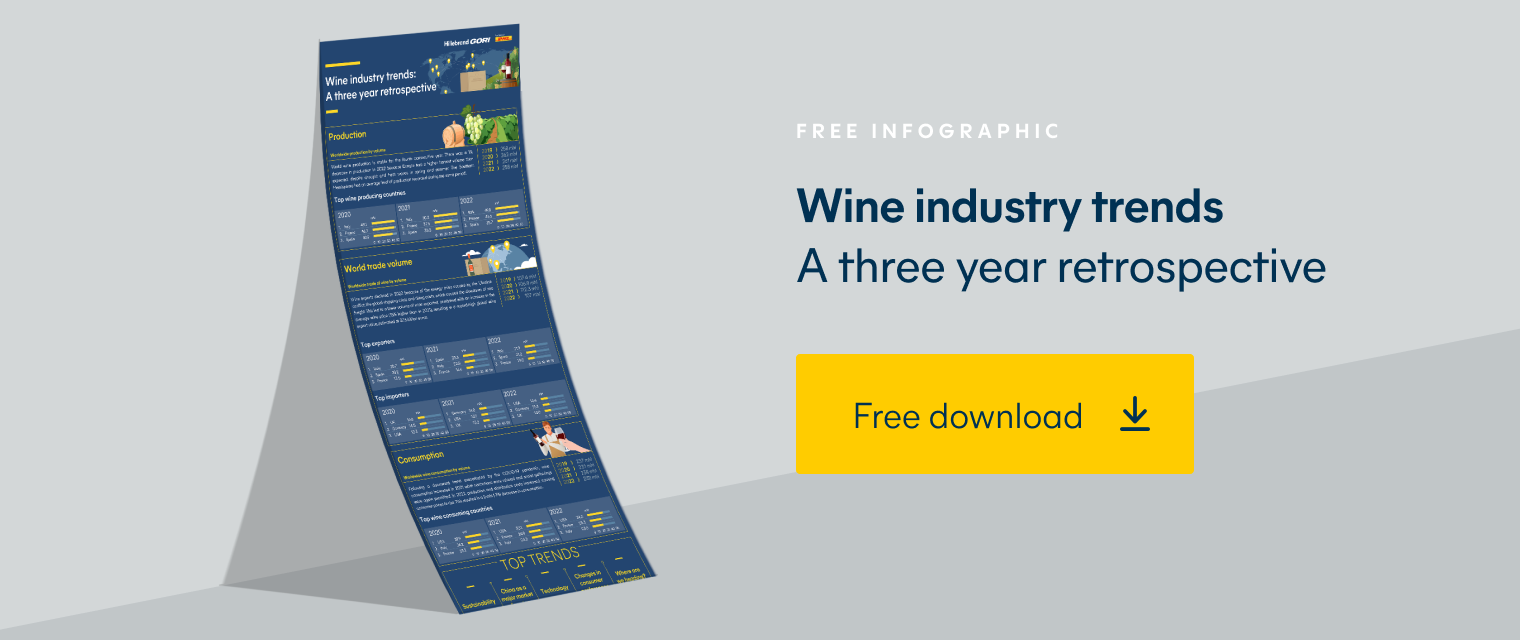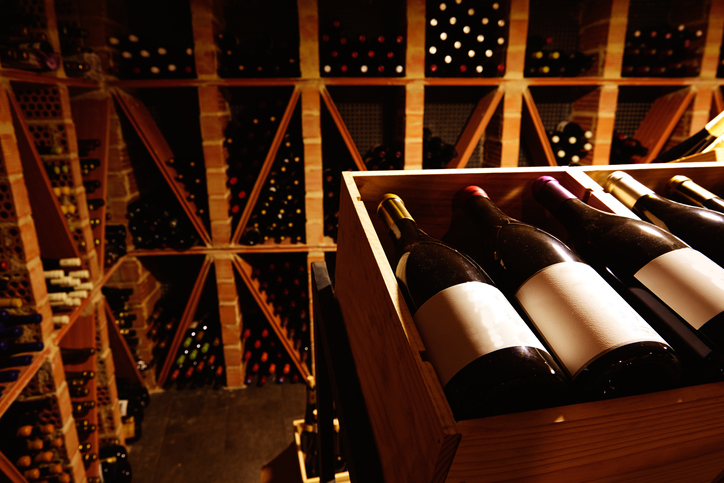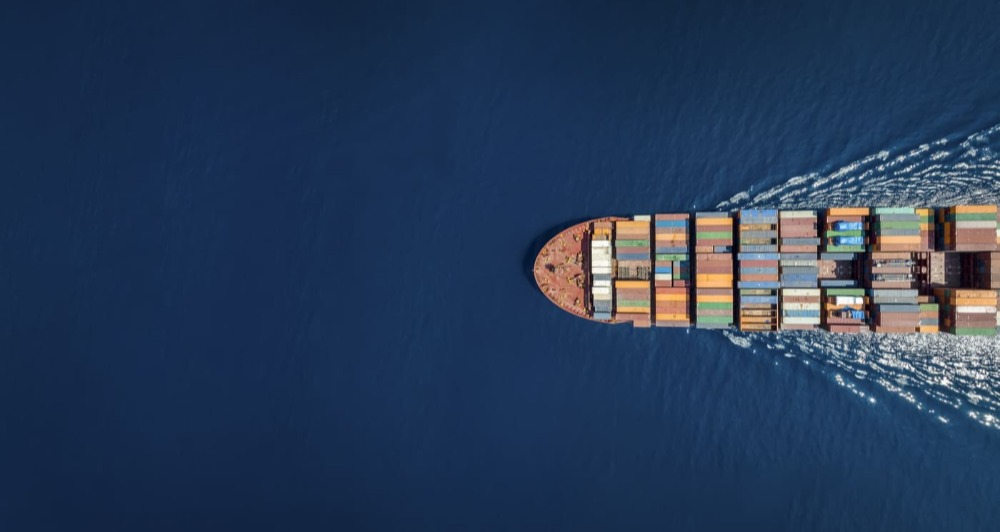A New World wine tour for wine importers
In the wine business, an important difference between wines is whether they are Old World or New World wine. But how much do you really know about this? Keep reading to discover all the essential facts a wine importer needs to remember.
What is considered the New World in wine?
New World wine comes from countries like the US, Canada, Chile, Argentina, South Africa, Australia, and New Zealand. Compared to the thousands of years of viticulture in Europe, these regions have a relatively short history when it comes to winemaking. Wines made with modern methods in China and other countries in Asia, Africa, and Oceania are considered New World as well.
The US is the biggest player among New World wine nations with the largest vineyard surface area at an estimated 390kha (kilohectares). Argentina comes in second with 207kha and Chile a close third at 196kha.
Here’s how the New World wine countries measure up as a percentage of world vineyard size:
- USA 5.4%
- Argentina 2.8%
- Chile 2.7%
- Australia 2.0%
- South Africa 1.7%
- Brazil 1.1%
Why are some wines considered old world or new world?
In the 15th Century, many European countries started conquering and colonizing other parts of the world during the Age of Discovery. As they spread around the globe, they took wine, grapes, and wine-making with them to these “new” territories. First to North and South America and later to Australia, New Zealand, and South Africa. Wine produced in these former colonies is what we now call New World wine and the wine from European countries is classed as Old World.
What’s the difference between New World and Old World wine?
The overall distinction between these two classes of wine comes down to the intentions of the winemakers. The art and craft of Old World producers is aimed at expressing the terroir, the contribution the local soil and unique environment make to a wine's taste. In the New World winemakers concentrate on what the grape variety brings to the wine. This is why Old World wines are basically known for their region of origin such as Bordeaux, Barolo, or Rioja, while New World wines are known for the grape variety.
New Zealand for example is famed for its Sauvignon Blanc, particularly from the Marlborough region. With intense aromas of citrus and exotic fruits, New Zealand Sauvignon Blanc has established itself in a space that was once dominated by France.
Argentinian winemakers are now masters of the Malbec grape. It produces full-bodied, richly colored wines with black fruit flavors and mellow tannins.
Shiraz started its life in the Rhône Valley where it's called Syrah, but has since become the signature wine grape of Australia producing bold, rich, fruit forward wines. Similarly, the Semillon varietal is used to make some premium wines in a distinctly Australian style. If harvested early and aged in a bottle it acquires flavors of honey and toast.
How is the New World wine industry performing?
Let’s take a look at some key facts and figures to get a picture of winemaking in the most important New World wine countries.
How much wine is produced by New World wine countries?
In the US, wine production in 2022 was estimated to be 7% lower than 2021 and 9% lower than the five-year average.
Production has also fallen in most South American wine-producing countries compared to 2021.
In Chile, the largest producer on the continent, output in 2022 was down 7% and in Argentina production was 8% lower.
On the other hand, Brazil increased wine production by 9% in 2022 compared to the previous year and its output was also 14% over the five‐year average.
It’s good to note that New Zealand saw a huge 44% increase in production last year with a record-high of 3.8mhl.
2018 | 2019 | 2020 |
|
|
| 2022% | |
USA | 26.1 | 25.6 | 22.8 | 24.1 | 22.4 | -7% | 8.7% |
Australia | 12.7 | 12.0 | 10.9 | 14.8 | 12.7 | -14% | 4.9% |
Chile | 12.9 | 11.9 | 10.3 | 13.4 | 12.4 | -7% | 4.8% |
Argentina | 14.5 | 13.0 | 10.8 | 12.5 | 11.5 | -8% | 4.4% |
South Africa | 9.5 | 9.7 | 10.4 | 10.8 | 10.2 | -6% | 3.9% |
New Zealand | 3.0 | 3.0 | 3.3 | 2.7 | 3.8 | 44% | 1.5% |
Brazil | 3.1 | 2.2 | 2.3 | 2.9 | 3.2 | 9% | 1.2% |
Sources: OIV, GTA
How much wine do New World wine countries export?
Out of the main New World wine-exporting countries, only Australia and Canada did not experience a decline in export volume compared to 2021.
US wine exports decreased by 14.7% in 2022. On the other hand, export value increased by 11.8% to €1.4bn thanks to a general rise in the price of bottled wine.
In Chile, the fourth largest exporter of wine in the world by volume and value, volume fell by 4% in 2022 although value increased by 9% to reach €1.8bn.
Argentina suffered a significant 21% drop in relative volume. But as elsewhere, it benefitted from a 7.4% rise in value compared to 2021.
Volume (mhl) | Value (€bn) | |||
2021 | 2022 | 2021 | 2022 | |
Chile | 8.7 | 8.3 | 1.66 | 1.82 |
Australia | 6.3 | 6.4 | 1.35 | 1.38 |
South Africa | 4.8 | 4.4 | 0.63 | 0.66 |
New Zealand | 2.8 | 3.0 | 1.17 | 1.35 |
US | 3.3 | 2.8 | 1.25 | 1.39 |
Argentina | 3.3 | 2.7 | 0.7 | 0.75 |
Canada | 2.1 | 2.1 | 0.07 | 0.08 |
Sources: OIV, GTA
Which New World wine countries are the biggest importers?
The US is the world’s largest wine importer by volume. It imported 14.4mhl in 2022, a 3% increase on 2021. It’s also the top country in terms of value with an increase of 17% on the previous year equalling €7.0bn of wine imports.
Canada is the only other New World wine country to appear in the top 10 of global wine import countries. In 2022, it imported 4.2mhl, showing no change from the previous year. However, in 2022 Canada spent €2.2bn on wine imports, a 14% increase in value on the 2021 figure.
Volume (mhl) | Value (€bn) | |||
2021 | 2022 | 2021 | 2022 | |
USA | 13.9 | 14.4 | 5.9 | 7 |
Canada | 4.2 | 4.2 | 1.9 | 2.2 |
How much wine do New World wine countries consume?
With a consumption of 34.0mhl in 2022, the US remains the largest wine-consuming country in the world. That’s almost 3% higher than 2021, and marks a return to pre-pandemic levels.
Argentina, the biggest wine market in South America, consumed 8.3mhl in 2022, 1.3% less than in 2021.
Consumption also fell in Brazil. In 2022 it was down by 12.9% compared to record-high levels seen in 2020 and 2021.
South Africans consumed 16% more wine in 2022, reaching 4.6mhl, the country’s highest figure ever.
2018 | 2019 | 2020 |
|
| 22/21% | 2022% | |
USA | 33.7 | 34.3 | 32.9 | 33.1 | 34.0 | 2.8% | 15% |
Argentina | 8.4 | 8.9 | 9.4 | 8.4 | 8.3 | -1.3% | 4% |
Australia | 5.3 | 5.8 | 6.0 | 5.7 | 5.5 | -3.2% | 2% |
South Africa | 4.2 | 3.9 | 3.1 | 3.9 | 4.6 | 15.8% | 2% |
Canada | 4.9 | 4.7 | 4.4 | 4.2 | 4.2 | -0.4% | 2% |
Brazil | 3.3 | 3.6 | 4.1 | 4.1 | 3.6 | -12.9% | 2% |
Sources: OIV, GTA
How do you safely transport your New World wine?
Working with an experienced beverage freight forwarder like Hillebrand Gori is the best way to transport your New World wine safely and with every drop of quality kept intact. We have offices in every market where wine is crafted and consumed, so you’ll know that your wine is always in safe hands.
To move wine from the New World, sea freight is the most carbon-efficient mode of transport. It’s also economical for any size of wine shipment, from bottles to cases to pallets, making it the prime choice for international freight shipping.
We offer direct sea freight services with different transit time options, so you can choose what's right for you.
For example, to move young wines in bulk, a flexitank is cost-effective, efficient and safe. Hillebrand Gori’s flexitanks are designed with a protective barrier to prevent oxidation and keep out taint compounds. They also let you ship 24,000 litres, more than double the volume of a single container of bottled wine.
For bottled wine, you can use our Full Container Load (FCL) service to move large volumes or choose our Less Than Container Load (LCL) option if you want to send a smaller amount and share the cost with other shippers. Thanks to our groupage services you can be sure that your wine will only travel with other beverages and be safe from contamination.
If your New World wine shipment is urgent, our IATA-approved global air freight services are the fastest way to get your wine to its destination anywhere in the world. We work with trusted airline carriers to safely and securely transport any volume of alcohol with speed, from a single bottle to 100 tons of wine pallets.
Whichever transport mode you choose, you can rely on Hillebrand Gori to deliver your wines on time and in optimum condition.
How can we help your business grow?





